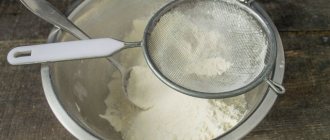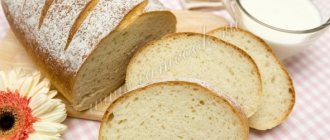History of the baguette
It is believed that such a bakery product first appeared during the reign of Napoleon. According to legend, it was supposed to be worn directly in the pants, but this legend does not stand up to criticism, since by the evening such a product would no longer be edible.
A more plausible version is the one in which the authorship of the baguette belongs to Austria. In 1839, a store was opened in the capital of France selling Austrian baguettes, which were so loved by the townspeople that this product became one of the popular symbols of the country.
Since that time, many recipes have changed, but the classic recipe for a French baguette in the oven with a photo can be read below. This recipe was first formed in 1993, when France issued a law allowing bread traders to carry on their business and not be afraid of supermarket competition.
LiveInternetLiveInternet
France has many symbols - Notre Dame Cathedral, the Eiffel Tower, Montmartre attract tourists from all over the world. Fleur-de-Lise, the Gallic rooster, Joan of Arc and even the nickname of France since 1792 - Marianne - cannot completely “write” a complete portrait of the country. Without French baguette, croissants, oysters, foie gras, wine and Roquefort, one can hardly understand the character of this romantic state. The French baguette was born in Paris, over time it became a traditional bread in many countries of the world, without losing its philosophical essence - a hard crust with a fresh crumb inside.
Origin story
This unique symbol of France is the French white loaf, more commonly the French baguette (French une baguette de pain), which is a long and thin baked bread. A distinctive feature of a baguette is its crispy, fried crust, with a soft “content”, often dusted with flour. A standard baguette has certain dimensions: a length of approximately sixty to seventy centimeters, a width of five to six and a height of three to four centimeters, while weighing about 250 g.
The French baguette first appeared in Paris in the twenties of the last century. It is no coincidence, since it required less time for dough and baking to germinate than regular bread. This event occurred after the release of a government law prohibiting all employees from starting work before four o'clock in the morning. The innovation did not allow bakers to prepare the usual yeast bread for their consumers’ breakfast; they simply did not have time. The baguette replaced the French bun (in Russia they used to call it “urban”), because creasing the longitudinal seam of this bun was a real feat. By switching to baguettes, the French fired most of the bakers, as the baking process sped up. So the state law served as an impetus for the emergence of a new recipe for bakers and job cuts.
Characteristic features of the baguette
Cutting a fresh French baguette is very difficult, so traditionally it is broken. His character is not simple: by the end of the day, this bun becomes stale and loses all its unique properties, like Cinderella’s carriage turned into a pumpkin.
In France you can find several types of such bread, different in shape, taste and length: traditional baguette, in the form of an ear, a rustic baguette, very thin, which is lovingly called “thread”, baguette according to a special recipe from the chef and many others.
In an attempt to anticipate the growing needs of their customers, many bakers are making baguettes in a wide variety of lengths and degrees of baking. In the morning, this bread on the shelves of French bakeries is always warm; among the rich assortment of fresh baked goods, you can choose short or long, ruddy, pale or slightly burnt, to suit any budget and the most sophisticated taste.
One of the French baguette recipes
In the capital of France, more than half a million of the freshest baguettes are sold every day. A French baguette weighs exactly two hundred grams, it is prepared like this: first, put a dough of flour, yeast and water for twenty minutes, then add more flour, salt and water, knead for exactly ten minutes and let it sit for forty-five minutes. Then they cut into long thin loaves, make three traditional cuts, cover with a damp cloth for forty minutes to rise the dough, bake for 15-20 minutes until a crispy crust forms.
This is interesting
Most bread is eaten in Germany, but France holds the palm for producing the most delicious buns in the world. The French baguette contributed to this list as much as possible: its important component is an appetizing crust, fresh, aromatic and crispy. Crunch is the main sign of a good real baguette, biting off a piece of this bread, the words of the famous song instantly come to mind: “... the waltzes of Schubert, and the crunch of a French roll...”, creating a mood, transporting in memories the carefree and harmony of comfort.
The most unforgettable impression remains from the process of tasting this aromatic piece of bread: in France, along with the morning baguette, they serve butter and a large cup of rich coffee. The taste lies in the fact that after breaking off a crispy baguette, spreading it with butter, you quickly lower this sandwich into a cup. The butter will not have time to melt; the delicate crumb will quickly absorb the thick coffee. All that remains is to put this miracle of gastronomic thought into your mouth, receiving a whole range of unusual taste sensations. What gives pleasure cannot harm either the soul or the body.
Zhanna Pyatirikova
Homemade recipe
French baguette can be found not only in the vastness of France, but you can also prepare it yourself at home. This process is not difficult, on the contrary, it is interesting and enjoyable. There are many recipes for this product. Below we will present one of the classic options for preparing a French baguette.
Ingredients for making three baguettes:
- pressed yeast – 15 grams;
- white flour, premium - 3.75 cups, approximately 480 grams;
- warm and clean water – 300 ml;
- a small amount of oil so that the dough does not stick to your hands;
- sugar - about five grams;
- salt – approximately 7 grams.
During cooking, it is better to keep the oil nearby, as it may be needed to lubricate the table and utensils.
Homemade French baguette recipe:
1. Sift all the flour into a very large bowl. You can repeat this process 2-3 times, then the flour will be saturated with more oxygen and will help the yeast develop better.
2. Break the pressed yeast into the sifted flour into small pieces. You can do this by hand.
3. Add salt and sugar to this mixture.
4. Grind the yeast in the flour with your hands until it becomes fine crumbs. The mixture should be homogeneous.
5. Place the pureed flour and yeast in the middle of the bowl and make a well. Pour water into it. The water temperature should be around 400.
6. Mix everything with a fork.
7. Sprinkle the table with flour, place the resulting dough on it and knead further on the table.
8. The dough should always remain slightly sticky and very soft.
9. To avoid problems with it sticking to your hands, you need to lubricate them with a small amount of sunflower oil. You can do the same with the table by adding a thin layer of oil to it.
10. Knead the dough for at least 20 minutes. If kneading takes less time, the dough will not be fluffy enough, and this is necessary to create the right baguette. After about five minutes of kneading, it stops sticking and the process becomes easier.
11. Place the dough in a greased bowl. Cover with a towel and place near the radiator for 90 minutes.
12. When it rises, dump it back on the table.
13. Divide it into 3-4 parts.
14. Form each part into a rectangle using your hands. Its dimensions should be smaller than A4 sheet size.
15. Fold one long edge towards the center.
16. Wrap the second one like the first one.
17. Fold the first and second edges again and secure the edges.
18. Roll the future baguette on the table so that it stretches out. The thickness should be the same along the entire length.
19. Repeat the entire process for the remaining two pieces.
20. Place them on a floured baking sheet about five centimeters apart.
21. Cover with a towel and place in a warm place for half an hour.
22. Preheat the oven to 200 degrees.
23. 10 minutes before the moment when the baguettes should be sent to the oven, you need to make diagonal cuts on them.
24. Before putting the products to cook, you need to take a cast-iron frying pan or metal utensils, heat it on the stove, and put it in the oven. Then place the baking sheet with the future baguette.
25. Pour cold and clean water into the dishes under the baking sheet.
26. Close the oven.
27. Bake for half an hour at a temperature of 200 degrees or more until a golden crust appears.
28. Take out the finished dish and in order for the crust to be soft but crispy, you need to cover it with a towel, sprinkling a little water on the baking sheet before doing this. Wait about five minutes for the end of cooking.
Taking note of this recipe for a French baguette in the oven, you can delight your family and friends with fresh and crispy bread.
French twisted baguette.
What is a French baguette? This is a long, thin bun made from wheat flour, with a crispy, hard crust and a soft, flavorful, holey crumb. A standard baguette is usually 65 cm long, 4 cm wide, and weighs approximately 200 g. It is made from only four components: wheat flour, yeast, salt and water. That is, in essence it is lean bread! And, since the French baguette does not contain a drop of baking, it tends to quickly become stale. Therefore, such bread must be eaten before evening. Historians say that French baguette bread appeared in the twenties of the last century. This was the response of Parisian bakers to legislation prohibiting work before 4 o'clock in the morning. Since ordinary bread, if you start cooking it after 4 o’clock, did not have time to bake for the Parisians’ morning breakfast, savvy bakers came up with a technology for making baguette bread, which took less time. The dough for the baguette was made in the evening, and the loaf itself was baked early in the morning, just in time for breakfast. There are simply no words for how convenient it is! Crunch is an essential sign of a good baguette, but it should not be confused with crunchiness. Due to the characteristic thick crust, the baguette is very difficult to cut, so it is customary to break it by hand. Or, after all, if you do cut it, then cut it lengthwise. The second reason why you need to cut a baguette lengthwise is the filling. During baking, large and numerous holes form in the baguette crumb. And if you cut a baguette into regular slices, the filling will simply fall out or leak out, which is not good. More than half a million fresh baguettes are bought every day in Paris. The French baguette is one of the symbols of France, just like the croissant, foie gras or French perfume. Looking into a Parisian cafe in the morning, you can see the following picture: a Parisian cuts a crispy, rosy baguette lengthwise, spreads butter on the exposed crumb, quickly dips the resulting sandwich in coffee, so that the butter does not have time to melt, and the crust of the baguette does not get wet, and immediately into his mouth! Paradisaic delight! If you care what kind of bread you eat, if you want to pamper yourself and your loved ones with fresh baked goods, but you are sorely short of time for this pleasure - BAKE A FRENCH BAGUETTE!
INGREDIENTS for 2 baguettes:
500 g flour 320 g water 5 g dry yeast 1.5 tsp salt.
Preparation:
It is very important to maintain exact proportions. Let's start preparing the dough late in the evening... If you have a bread machine, knead the dough in it, set it to normal mode - this will take 15 - 20 minutes. Remove the dough from the cup with a silicone spatula; it should be runny and very sticky. Place in a deep cup with a lid, rest according to the recipe. I also have a bread machine, but I want to make the dough by hand, and just for you. To clearly show what kind of dough should turn out. Dissolve the yeast in warm water, this will take about 10 minutes.
Be sure to sift the flour. I do not recommend skipping this stage. Even in the most extraordinary production they do this. By sifting flour, we saturate it with oxygen. Add salt to flour and mix.
Make a well in the center of the flour and add the yeast mixture. We will add in small portions. Mix each portion with flour. Knead, of course, by hand.
And now the most important thing... The secret of a French baguette is in the water! Or rather, in its quantity. As with ciabatta, the French baguette dough needs to be very runny and very sticky. Sticky so much that it sticks to everything. To the hands, to the table, to the tools. Some people may not like it, but there’s no other way. And, as the French say, water in baguette dough is everything to us! Battery dough makes a great baguette!
Kneading such dough is more inconvenient than difficult. Salvation is a bread machine. But we are not looking for easy ways... Let's be patient and knead with one hand, and hold the cup of dough with all our might with the other. To be honest, from the outside it looks very funny! After 10 minutes of intensive kneading, exhale. We coped with this difficult task. Spread the dough over the bottom of the cup, cover with a lid and leave for 15 minutes.
We wet our hands in water and quickly and quickly assemble the dough into a bun. With wet hands we go along the walls and bottom of the cup, putting it back into the cup.
You probably noticed how your dough changed during these 15 minutes? Yes, yes, it began to stick to your hands less and became incredibly tender. Close the cup with a lid and leave it directly on the table at room temperature. It's time to forget about the dough, for 12 - 14 hours. In our case, this is just for the night. You can bake it in the morning, or you can bake it for lunch, it’s up to you. This is the dough I have, after 14 hours...
Before your dough ends up on the work table, lightly dust the table with flour. WE DO NOT LEAVE THE DOUGH OUT OF THE CUP, BUT TURN IT OUT, AND WAIT PATIENTLY!
What an important person, barely... Well, finally, it’s on the table.
To get a good look at the structure of the dough, it is not necessary to photograph it close up! Even from afar you can see how airy and lacy it is. We don’t knead the dough, we don’t poke it with our fingers!!! We collect flour into a sieve and powder it again, but this time on top of the dough.
Now, we need to divide the dough into 2 parts. This must be done with a special wide spatula - a scraper. I don’t have a special one, but I have a soft silicone spatula, which is also not bad. It's time to form the loaves. There are two types of baguette - a regular baguette and a twisted one. A regular baguette is for toasting, it is cut. Secondly, it is more convenient to break it, since it has a narrowed shape in several places at once, which is obtained by twisting the dough. Today we will look at the second option.
I will say, this is a pretty sweet and enjoyable activity. And, it takes some getting used to rolling out, but it’s worth it! Before you start stretching and rolling the baguette, prepare some baking paper. The size of the paper should match the size of your baking sheet. We do not lubricate the paper with anything, otherwise the dough will be weak and will simply spread into the oil. The baguette will be baked with flour. This is why we torment the table well when we dump the dough on it, and then also on top of the dough. The ideal length of a French baguette is 65 cm, in our case 50 -55 cm, it will no longer work due to the size of our standard ovens. Place the paper on a flat surface, next to you. We take a piece of dough from both ends, with both hands, quickly lift it and “throw it” onto baking paper. During the transfer process, the dough will stretch under its own weight. All you have to do is twist it. This must be done very carefully, the dough is incredibly tender. There is no need to be afraid that it will fall off, but it is undesirable to pull it out more than it should be. Again, let me remind you that a thickness of 4 cm is normal. But no less. Start twisting from the middle to one end, then also from the middle, but in the opposite direction. It would be ideal to make 2 - 3 turns from each end, no more. Like this…
To avoid the dough sticking together, place thin towels rolled into a rope or roll between the baguettes and on each edge. Cover the dough with a light towel and leave for about 1 hour. 25 minutes before baking, start preheating the oven along with the baking sheet. It is very important! We set it to the maximum, our capabilities are from 220 to 250C. Place a cast iron frying pan on the bottom of the oven. Or any other that you don’t mind heating. French baguettes are baked goods with a small specific gravity; they are baked quickly and always at the highest possible temperature and humidity. The temperature during the baking process gradually drops to the optimal temperature. High temperature helps open the cuts and increase the volume of the bread itself. Humidity prevents a too thick crust from forming too early. We move the baking sheet with baguettes closer to the oven, remove the towels. We take out the hot baking sheet (don't forget to put on gloves) from the oven and quickly, carefully drag the baking paper onto it along with the baguettes. It seems that this is difficult to accomplish, but in fact, everything is simple. We take a full 250 g glass of water, maybe a little more, open the oven and pour it into the frying pan. Carefully place the baking sheet in the center of the oven, and also carefully close the door. The baking process has begun! I bet you, now you are squatting and looking through the oven window!!! Bake for 20 minutes, then reduce the temperature to 180C and continue baking for 15 minutes. Open the oven, the baguettes should be nicely browned. If you knock on a baguette, you will hear a dull sound. There is no need to remove hot baguettes from baking paper immediately. Just cover them with a towel and leave them alone for 10 - 15 minutes.
The French baguette crunched with its crust, I looked from the window at the passers-by and laughed, I probably wanted to get into my mouth as soon as possible, and I was surprised at the fleeting life. And the circle of friends thinned around him, They were bought and the tops were torn off, The baguette whispered: “So, it’s destined...” But he was not sad about it. The madam quietly approached the counter, And handed the euro to the saleswoman, And in a moment the soul began to beat in the crumb, The baguette swayed from the proximity with the Frenchwoman. He was floating in his arms as if in the clouds, Enjoying his new mistress, She suddenly brought him to her lips... He wanted to stay near them forever. I felt the touch of the tongue, I almost lost my mind here, the baguette crunched, I was simply crazy, and fell in unconscious crumbs onto my jacket.
Igor Nikolaevich Frolov
But the baguette is already cut. I cut it with a special knife with teeth. The crust is much thicker than regular bread. With a characteristic ringing crunch! The crumb is white, tender and slightly stretchy. With numerous small ones and, in some places, simply outrageously huge holes! Long live the French baguette for breakfast!!!
Every year in France there is a competition for the baguette of the year. The winner bakes baguettes for the president himself and his family. I advise you to follow the link and read and see photos of this event. They listen to the baguette, taste it, smell it, look at it through a magnifying glass...
So, if you didn’t get that famous loaf the first time, don’t be discouraged!!! Try, create, search, in a word - don’t stop there!
Types of baguettes
There are three types of baguettes in the world that differ from each other. The first option is a classic baguette with a golden or yellow crust. The weight of such a product is about 250 grams.
The second type is a molded baguette. It is baked in industrial ovens and has a pattern on its base, indicating that it is made using machinery.
The third type is farine. This baguette is sprinkled with flour before cooking, so it does not have a crispy crust. However, it can be prepared according to the classic recipe. Photos of different types of French baguettes will be shown below.
Despite the differences, each of these types of baguette has excellent taste and will suit almost any table.










